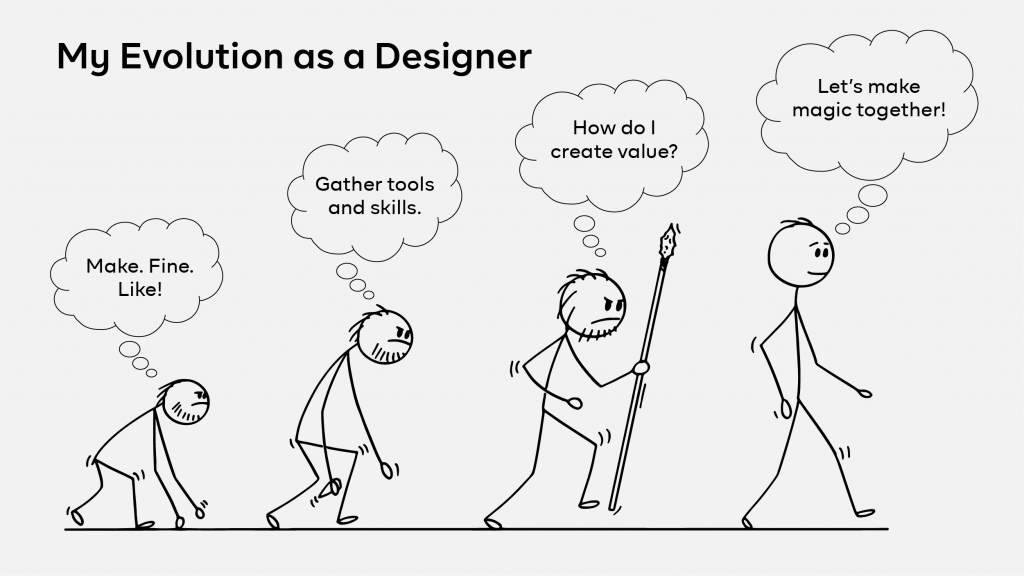
What are the top skills for designers who want to stand out? Does it stop at just the art of design or are there other skills you need to imbibe to enjoy growth on the corporate ladder? This guide details my “evolution” as a designer and in it, I share the top skills that have helped me thrive at work. Before I list them, let’s start from the basics.
These days, the barrier to entry for designers is very low. All you need is a laptop, YouTube tutorials, and a desire to learn. With these, you can begin to build a design portfolio. Although it’s still not an easy feat, having mastery of all industry-standard design tools as well as a good enough portfolio is the right step for anyone starting out.
But that’s not all. Core design skills alone (which now seem to be everywhere) are not enough to get you the coveted position, recognition or pay you think you deserve. To stand out from the crowd, you would need to consciously acquire soft skills beyond the design craft.
When I started graphic design, my main concern was to make beautiful things in 2D – flyers, posters, digital banners…. After successfully scaling that barrier, the next step was to collect all the “Infinity Stones” of the design gauntlet, working with numerous software and designing in more dimensions than one.
My third step was to link the beauty of design to the creation of value.
The fourth step, which I consider the most important, is applying the beauty of design to create value for business. For this, you will have to learn to work with teammates as it requires constant collaboration. For introverts, this might sound like a burdensome part of your work. “Why do I need to work with others when I can just produce my best work alone in my room?” (I still think like this sometimes).
The truth I’ve found is that everything is connected and working with talented team members in cross-functional settings can significantly improve your output, as well as the quality of your work.

To work successfully with others, both externally with clients and internally with colleagues, here are some skills you need to thrive. They’ll help you get ahead in your career and I’ve included tips on how to acquire them. They are in no particular order, but should all be considered important.
Understanding business goals
Design is a form of expression and definitely has its aesthetic value. But in business, your design has to generate value and that value would be tied to the company’s bottom line. The key thing every employer or client would love to understand is “How will your designs increase my revenue?”. To stand out from the crowd, study the business of design and also your clients’ business to understand how best to add value in their context.
Curiosity
Creativity is sometimes a subconscious process. For your subconscious to work in your favour, you have to feed it with relevant material to marinate on. Being curious and constantly searching for new things and experiences will fill your mind with the fuel it needs to create awesome work.
Passion for growth
Anything not growing is dying; this is true for your skills as well. If you remain with the same skillset and knowledge you had 5 years ago, you will soon be overtaken by those who have honed the top skills for designers. Always seek new ways to improve. Gain knowledge by learning new skills, taking courses, attending seminars, reading wide and connecting with leaders and peers in your field.
Patience and endurance
You’d definitely need this one.
A good number of all projects you do will look like this, with the number of file versions approaching infinity. There’ll be drafts, edits and reworks that could almost make you go crazy. But remember that often times, it eventually makes the work better. Even when it doesn’t, console yourself with the fact that you’re building a virtue. Creativity can come as a result of repeating one thing and finding new ways of making it better. Also, avoid adding “final” to your file name. You’ll jinx it ?.
Effective communication
Great ideas are useful and good for business, but it is crucial to be able to communicate their advantage. Learn to accurately share your thoughts in writing and speaking. Take up opportunities to practice public speaking and learn how to make killer presentations. This way, you become a more valuable team member.
Negotiation and persuasion
Beyond communicating, sometimes ideas need to be pushed. In the course of your work, you’ll have to persuade teammates and superiors to go with your idea. Study your colleagues and understand what works for each person. Learn to approach them the way they would like to be approached and discuss your ideas at appropriate times. A good book that can help you with this is “How to Win Friends and Influence People” by Dale Carnegie.
Humility and a beginner’s mindset
Keep in mind that you can be wrong and that’s fine. When working in cross-functional teams with people who do not specialise in visual design, there is the temptation to believe you know what works best. And you may… But always treat your colleagues with respect and listen to their opinion. Creativity sometimes happens by chance and inspiration can come from anywhere, or in this case, anyone.
Accountability
Just because I hear people complain about this often, I’ll say this is one top skill for designers you should take very seriously. Creatives are usually culprits for missing deadlines and that should not be you. The tendency is to underestimate how much time you need to do great work and then overshooting timelines because you want everything to be perfect. “It just has to come out flawless”. This is not a bad trait in itself but it can work against you. You can end up losing the trust of your teammates because you never keep to time. Be sure to give adequate timelines, work diligently and always inform the team ahead of time if you need an extension. Also, remember that done is better than perfect…most times!
Money management
I made some good money when I first began freelancing, but after several months, I really didn’t have much to show for it. I was still as anxious as ever, and I took on jobs I should have said no to – just for the extra income. It’s important to set boundaries so that you can continue to do work you love without feeling like you “sold your soul” for money.
Also, I made what seemed like a tough choice at the time to keep a bit of what I earned locked up beyond reach with Cowrywise and have not regretted it since then. (Yes, I saved on Cowrywise before I joined the team).

Put the necessary steps in place to stay creative without money troubles. It’ll pay off in the long run.
Beyond the ones I’ve shared, necessary soft skills will differ from place to place and across industries, which makes it important to be observant and emotionally intelligent. Study your environment and adapt to what works best to excel. I am rooting for you.
Which of these top skills for designers are you already nailing and which others do you think should make the list?
Share with us in the comments. And don’t forget to send this article to your designer friends.

what will be measures taken against tax avoidance and tax evasion
Tax avoidance is legal. As for tax evasion, ensure you have the right information, be clear on tax evasion rules, watch out for red flags and know what you need to do to comply. Also, do your due diligence with third parties to avoid doing business with anyone who may be involved in tax evasion.